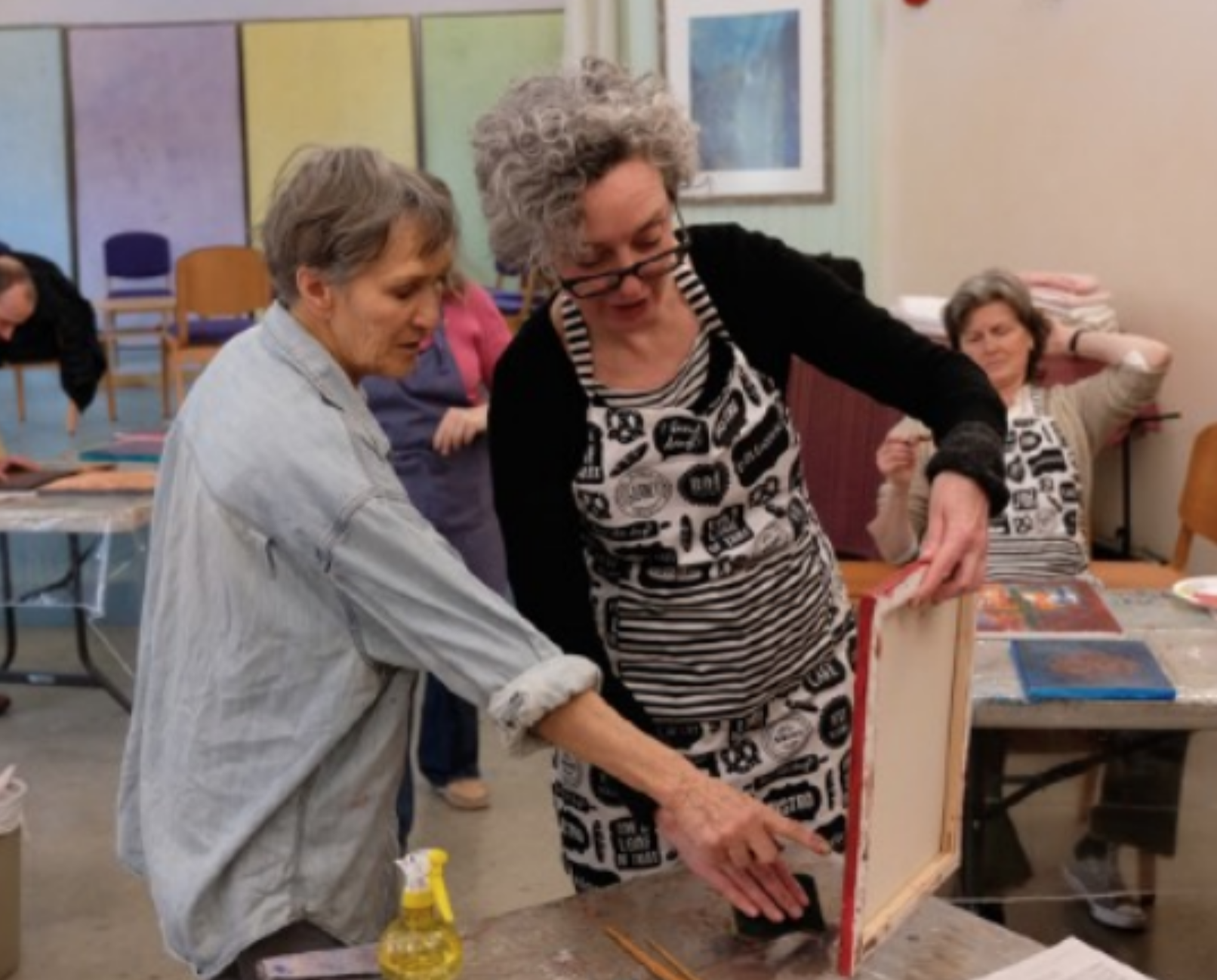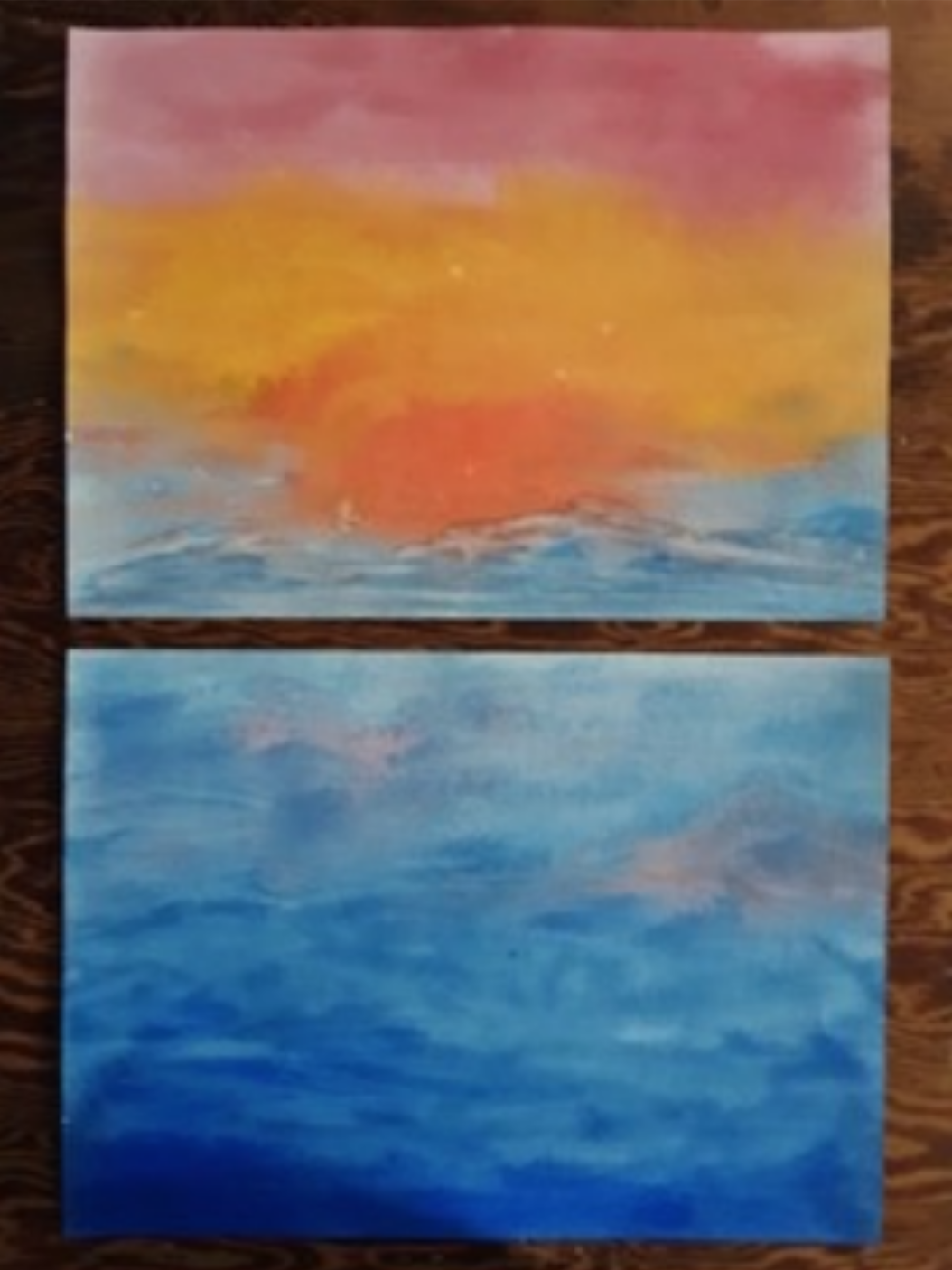A Way Through
Tish Pierce, Beginning Student, United States, interview with art teacher, Regine Kurek
From the Seminary Spring Newsletter, 2020
Every Monday during the autumn and winter terms in Toronto, the seminarians were given the space, the time, and the materials to create art! Our teacher and guide in this was Regine Kurek, the director and founder of Arscura, the school of art which is currently based at The Christian Community Church in Toronto. Regine has held her classes in this space for many years; now she is on the faculty of the seminary as well. After experiencing two terms of Regine’s classes I was curious and intrigued about how she had gathered all that she had brought to us. And so we sat down and talked about her background, her inspirations, and her mission.
At the end of our two semesters, Regine hung the “altar paintings” that we had made. It was a project that we worked on in the last three sessions, although Regine said that we could have worked on them for many, many weeks. We attempted these after having a myriad of experiences in the art classes. I was looking at these paintings with some community members who had participated in the Arscura Program and had done “altar paintings” as well. They were trying to put into words the experiences that they had had. It was something about “going through,” whatever it turns out to be. It is not so much about what you have in the end. I spoke to Regine about this.
Regine Kurek with Tish Pierce
Regine: Years ago, Jonah asked me to create an art process during Holy Week that he wanted to offer to the community. This became a five-day workshop with lectures by him and artistic explorations led by me through The Holy Week. He had led us through the Act of Consecration of Man, through its four stages—Gospel, Offering, Transubstantiation, and Communion. At that time, it became clear to me, more spiritually and more cognitively clear, that it truly was an archetype, what I had been offering out of my own experience in art classes. It was what I called “dying and being born, dying and being re-born.” I never consciously connected the two paths, the religious path and the artistic path; though, of course, in theory, I would have said art, science, and religion are one for me. And so there are layers of growing into this idea of art as a modality for transformation, for healing, for inner development.
Painting by Tish Pierce
I was interested in the layers. She brought so many different experiences to us in the art classes. In the first term we worked with wet-on-wet watercolor and in the second term some black and white chalk and conte drawing and acrylic paints—these were the media. The classes were filled with a variety of experiences brought to us in the form of ‘invitations.’ In the very first class, Regine invited us to create a kind of landscape of where you are now and then to share that with another person. So, we looked at each other’s paintings. We had breathing space. We had the opportunity to talk about our next task, which was to make another painting that was growing out of one of the sides of the original painting—to choose one of the four directions. R: I wanted to give an opportunity to expand from what was. It’s interesting to see “this is the future; this is the past.” We were given the space, the time and the materials to contemplate, to explore and to do.
What was her journey as an artist, therapist, and teacher? What were the layers? Regine did an art training, a teacher training, has a degree in Anthroposophical Art Therapy, and a diploma in Biographical Counseling. Her first teacher was Martin Domke, who was a friend of the family and a student of the Bauhaus teacher, Oskar Schlemmer. R: The Bauhaus ideal is that al the arts come together for the benefit and the purpose of human community in the Gesamptkunstwerk (a complete or integrated work of art). It was a deeply social ideal that they lived, too. As a child, she and her sister spent time in Martin Domke’s studio where he gave them paints and clay and told them stories. She later would do a Foundation Studies in Art with him. Her next teacher was Herman Kirchner who developed a real process for people with special needs with form drawing. He kind of lifted these socialist, even communist ideas into more of an anthroposophical and spiritual consciousness regarding the arts. And then with Rudolf Steiner and Waldorf pedagogy, a whole other layer came into this, that emphasized the deeper healing and spiritual dimensions.
I experienced her class as being artistically and, very subtly, spiritual and healing. It wasn’t just in the exercises she brought but how she brought them. We started each class sitting in a circle and spending time looking at the work from the previous class that Regine had hung, then she would bring something new for contemplation and then invite us to do an exercise that she had suggested. And at the end of class we would spend a good amount of time looking at each other’s work.
Things would come up in this process that touched on themes that we had been studying in the seminary. In the first term, we worked on a full color wheel with the light and darkness in it. Then we were to mix the reds and the blues from the sides and the black from the bottom to make peach blossom, which could be called a spiritual color. I was shocked in realizing that we had to add black in order to attain it! Later the peach blossom experience would come back in a feeling for me when we studied demonology and polarities in the class on the Gospel of St. Mark taught by Anand Mandaiker.
In the second term, we first started with exercises in black and white. Then, as a continuation, we did another with a base of black and white and added red to it and were asked to allow a face to emerge. Regine had worked with us in preparatory exercises in drawing faces, in scribbling faces, and drawing faces without looking and then she said, “you have the face in you.” A face did emerge and the experience was very strong. Was it demonic? Was it beautiful? My feelings about it went back and forth.
R: I love this exercise, to work with the black and white and then to bring the red in. It has both aspects—it could look quite demonic—it really has the whole gamut, right? When you bring the black and the red together, the peach blossom can emerge. And so both sides are there.
R: I heard so many times, from both Patrick and Jonah ( also in Jonah’s work with our community during the last three years even before the seminary was here), of what their aims are for the students: It’s not so much to produce beautiful art. That’s not why this is on display now [the exhibit of our work in the community room]. But it’s for you and for us, therefore, for everyone to experience —Can I go there artistically, can I bring myself into this situation and find myself in the unknown in some way, and come out the other end with something valuable? It’s not to fix everything or to be perfect, but to be able to do it, to be an example. The process of art-making goes through a crisis, goes through dying to a new birth. It’s a process that is painful; you bring something and you feel exposed. Most likely what you first see are the aspects of the unredeemed. So, you are constantly facing your double or your unfinishedness. And yet, if you are an artist you have these incredible ideals— many people do hold these imaginations of perfection, that we hardly ever reach.
R: This is what the directors of the seminary gave as the purpose or goal for the arts classes--to offer opportunities for the students to take this perspective: to meet myself and to recognize myself and, to reach further, to reach beyond. To recognize where I am - because you’re doing that al the time. You are assessing and self-assessing and you are being assessed - To recognize my vulnerability, maybe, my fragility, where I’m good, where I’m strong, and where I’m one- sided, or where I’m not practiced ...And, yet, to want to go further, without inflation, (these are my [Regine’s] words) without having to beat myself up, because we are no longer following the old path of self-flagellation. To find and walk that middle path, to find Christ in everything—in me, in this search, me on this path.
T. This brings us back to the original question. How is it different working with seminarians? Different from others in your classes? I think it’s not very different.
R: It is for every human being. This path, the artistic path, is the same for al of us, because I could say we are all artists. We are the priest, the artist, the healer, the teacher, right? We are in this creative field. We are working with human beings; we have to have creativity and we are doing that in the spirit. Again, it brings these-- art, science, religion—into a unity again; we have the possibility of becoming fully human. And that’s how I have always done this arts education. I was always interested in the human being. And then I use my tools and the things I have been taught. I’m so grateful to al my teachers, some of whom I mentioned. I knew it at the time, when I heard something— thinking, “this is where I want to go.” I brought the enthusiasm and the fire. I ofen said to people, al my life, I am on a mission—to work with Art as a spiritual journey or tool for education and healing and to work with people through art. Not for myself, just the lonely artist, but to create art together with others. It was a mission I came with, but it always, strangely, also came towards me as a challenging invitation.



